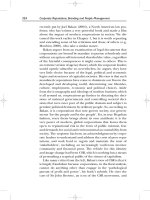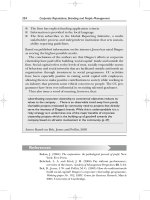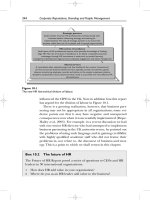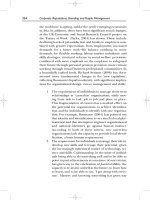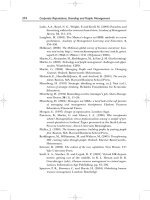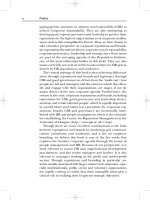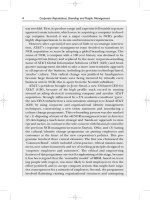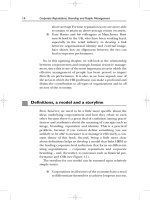Corporate Reputations, Branding and People Management 37
Bạn đang xem bản rút gọn của tài liệu. Xem và tải ngay bản đầy đủ của tài liệu tại đây (117.19 KB, 10 trang )
344 Corporate Reputations, Branding and People Management
Strategic partners
Small number of senior HR professionals working closely with
business leaders influencing strategy and steering its
implementation. The task of strategic partners is to ensure the
business makes best use of its people and its people opportunities
HR centres of excellence
Small teams of HR professional experts with specialist knowledge of 'leading-
edge' HR. The role of centres of excellence is to deliver competitive business
advantages through HR innovations in areas such as reward, learning,
management development, legal services, employee engagement and talent management
Shared services
A centralized, often relatively large, unit that handles all the routine 'transactional'
services across the business. Shared services typically provide recruitment, payroll,
absence monitoring, employee records and advice on the simpler employee relations
discipline and grievance issues. Shared services' remit is to provide low-cost, effective HR
administration
Figure 10.1
The new HR hierarchical division of labour.
Box 10.2 The future of HR
The Future of HR Report posed a series of questions to CEOs and HR
leaders in 30 international organizations:
1 How does HR add value in your organization?
2 Where do you as an HR leader add value to the business?
influenced the CIPD in the UK. Note in addition how this report
has argued for the division of labour in Figure 10.1.
There is a growing realization, however, that business part-
nering may not be appropriate in all organizations; some evi-
dence points out that it may have negative and unexpected
consequences even when it is successfully implemented (Hope-
Hailey et al., 2005). For example, in a recent discussion we had
with one senior HR director who had attempted to implement
business partnering in the UK university sector, he pointed out
the problems of using such language and in gaining credibility
with highly qualified academic staff who did not frame their
problems in, nor relate to, the discourse of business and strat-
egy. This is a point to which we shall return in this chapter.
Chapter 10 Creating a fit-for-purpose future 345
3 What credentials do you have to justify a seat at the strategy-making
table?
4 What returns on HR investment are generated in areas such as train-
ing and development, selection, rewards, etc.?
5 Do you have the right people in the right jobs to make a difference?
6 What advantages does your organization gain from the way it man-
ages human capital stocks and flows?
The report argued that the future of HR depended on its ability to
deliver three outcomes:
■ Excellent HR services at the least possible cost, consistent with
service delivery.
■ Expertise in critical areas such as organizational design, development
and change, and talent management.
■ Organizational capabilities and human capital, and making strong
inputs to strategic issues by influencing and shaping the decisions
of business leaders.
To achieve these outcomes, the report argued that HR had to trans-
form itself by (1) shifting in gravity from mainly transactional activi-
ties towards those focused on an organization’s performance, capa-
bility and effectiveness; (2) providing service excellence, value-adding
work and an orientation to thinking about the future; and (3) HR
people needed to advance their own technical and professional
capability.
It is worth quoting a passage to reflect the contingency perspective
they and other writers hold on HR business models:
Our proposition for the future of HR centres on the business context shaping
what HR does. Clarity about business drivers and organizational capabilities is
critical. This will define HR’s core work and challenges – and what its purpose,
position, structure, roles and capabilities should be. Yet such a scenario is far
from stable. Business environments are constantly shifting. No one type or
model of HR is automatically right. To be ‘fit-for-purpose’ an HR function must
be adept at analysing and matching, through its work, the emerging success
requirements and differentiators for the organization.
Source: Ashton and Lambert, 2005
HR, strategy and leadership
Perhaps more than any other figure, Dave Ulrich has helped
shape thinking among HR professionals in their quest for
relevance during the past decade, arguably because he has
been one of the few HR academics who have been able to ‘look
both ways’ – to the academy and practice – and claim credibil-
ity with both. He first put forward his ideas on the roles of HR
in 1996 and has updated these by drawing on his more recent
research (Ulrich and Brockbank, 2005). From our perspective
this updating has been important because of the greater focus
on HR’s impact on stakeholders, including employees, cus-
tomers and other managers dealing with branding and reputa-
tion management. In his earlier work, he defined HR’s four
roles as ‘employee champion’, ‘administrative expert’, ‘change
agent’ and the ‘strategic partner’, shown in Table 10.1. In the
more recent version with Wayne Brockbank, a fifth role of
‘HR leadership’ was added because it combined elements
of the others but also signified an important change in direc-
tion for HR as thought leaders influencing board-level policies.
Note how these roles mirror the historical development of
personnel in the UK and USA and have captured the drift of
management studies towards leadership during the past decade.
You might also want to reflect on how, like the findings of
the Ashton and Lambert study, these roles mirror (and may have
been the source of) the hierarchical division of labour in
Figure 10.1.
This division of labour and new role nomenclature probably
have been more widespread in Britain than America, perhaps
reflecting the greater influence and exhortations of the CIPD
than SHRM as a professional qualifying association, and the
generally lower status of HR practitioners in the business hier-
archy in the USA (Strauss, 2001). Moreover, the calls for HR to
become strategic partners have also enjoyed greater intellec-
tual support from four related ideas tied more closely to the
career interests of British HR professionals (see Box 10.3). We
cannot emphasize enough the importance of ideas in promot-
ing the interests of those who become its champion, known in
the ‘trade’ as ‘elective affinity’, especially in HR (Watson, 1977;
Elwell, 1996).
346 Corporate Reputations, Branding and People Management
Chapter 10 Creating a fit-for-purpose future 347
Table 10.1
Developments in the ‘Ulrich’ model
Old roles (1996) New roles (2005) Description of new roles
Employee champion Employee advocate ‘Caring for, listening to, and responding to
employees … while at the same time
looking through [stakeholders’] eyes and
communicating to employees what is
required for value creation
Administrative Functional expert Developing specialist knowledge and skill in:
expert Foundational HR practices, including
recruitment, promotions, transfers,
outplacement, measurement, rewards,
training and development; and
Emerging HR practices, usually not under
the direct influence of most HR
professionals, including work process
design, internal communications,
organizational structures, design of
physical setting, dissemination of external
information throughout the firm and
executive leadership development
Change agent Human capital Focus on the future of individuals and
developer teams, developing plans that offer each
employee opportunities to develop future
and abilities, match desires with opportunities
and master new skills
Strategic partner Strategic partner Bring know-how about business, change,
consulting and learning to their
relationships with line managers. They
partner with line managers to help them
reach their goals through strategy
formulation and execution by acting as
devil’s advocate, crafting strategies and
developing the strategic IQ of the business
HR Leader The sum of the other, four roles of
strategic partner, human capital
developer, functional expert and
employee advocate, plus
Leading the HR function, collaborating with
other functions by looking outwards and as
network integrators, setting and enhancing
the standards for strategic thinking, and
ensuring corporate governance.
Source: Adapted from Ulrich, 1996; Ulrich and Brockbank, 2005
348 Corporate Reputations, Branding and People Management
Box 10.3 Elective Affinity and HR in Britain
■ The growing influence of the RBV as a theory of strategic advantage
■ The promises of riches in achieving competitive success on the basis
of knowledge and innovation like the USA
■ The negative, though receptive context of the ‘British disease’ –
continuing low labour productivity associated with a low skills, low
growth dynamic (Porter and Taylor, 2004), especially compared with
competitor economies such as America, France, Germany and the
Scandinavian economies (Economist, 21 January 2006)
■ Perennial shortages of knowledge-based talent to resource new,
knowledge-based enterprises.
It is, perhaps, easy to see how such a combination of ideas and
theories has benefited the interests of HR in the UK, since HR
professionals have been able to point out how more effective
HR/HRD, targeted on boosting the knowledge base of British
organizations, may help Britain and British firms break out of the
vicious cycle of low skills–low growth. As a consequence, many
commentators in the UK in particular, but also in America and
Asia–Pacific region, believe that the HR function appears to have
transformed itself by appropriating a renewed sense of mission,
or is at least on track towards such a transformation if it is able to
address this agenda successfully. Measures of success for HR, as
we discussed in Chapter 6, have moved away from internal, trans-
action costs, such as costs of recruitment and HR headcount, to
externally focused ones that address the key strategic drivers of
the business (Boxall and Purcell, 2003; Huselid et al., 2005).
However, just how broad and deep such transformation has
been in the majority of organizations, especially in the public
sector, is very much open to question. De-bureaucratization has
been very evident among large MNEs, in small to medium-sized
organizations; while those in the public sector have remained
remarkably stable structures in the UK and USA (Sennett,
2006). The probability that HR transformations have been
noticeable and significant, outside of that small number of large
firms discussed in the media and by academics, is relatively small
(Sparrow et al., 2004). However, the need for such transformation
